2019 FIAT 500L LIVING steering wheel
[x] Cancel search: steering wheelPage 73 of 248
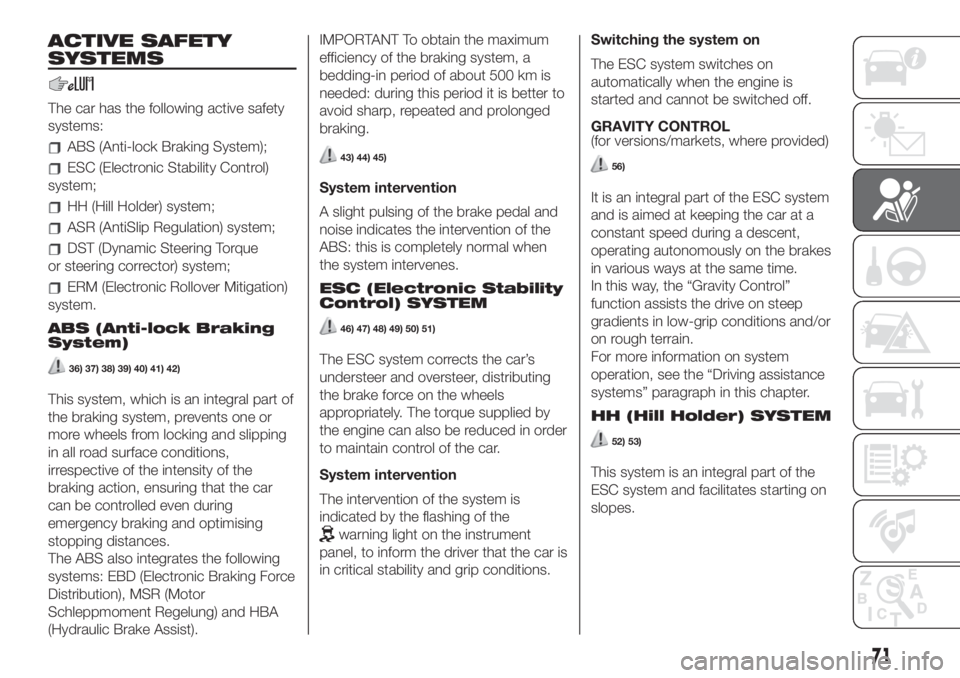
ACTIVE SAFETY
SYSTEMS
The car has the following active safety
systems:
ABS (Anti-lock Braking System);
ESC (Electronic Stability Control)
system;
HH (Hill Holder) system;
ASR (AntiSlip Regulation) system;
DST (Dynamic Steering Torque
or steering corrector) system;
ERM (Electronic Rollover Mitigation)
system.
ABS (Anti-lock Braking
System)
36) 37) 38) 39) 40) 41) 42)
This system, which is an integral part of
the braking system, prevents one or
more wheels from locking and slipping
in all road surface conditions,
irrespective of the intensity of the
braking action, ensuring that the car
can be controlled even during
emergency braking and optimising
stopping distances.
The ABS also integrates the following
systems: EBD (Electronic Braking Force
Distribution), MSR (Motor
Schleppmoment Regelung) and HBA
(Hydraulic Brake Assist).IMPORTANT To obtain the maximum
efficiency of the braking system, a
bedding-in period of about 500 km is
needed: during this period it is better to
avoid sharp, repeated and prolonged
braking.
43) 44) 45)
System intervention
A slight pulsing of the brake pedal and
noise indicates the intervention of the
ABS: this is completely normal when
the system intervenes.
ESC (Electronic Stability
Control) SYSTEM
46) 47) 48) 49) 50) 51)
The ESC system corrects the car’s
understeer and oversteer, distributing
the brake force on the wheels
appropriately. The torque supplied by
the engine can also be reduced in order
to maintain control of the car.
System intervention
The intervention of the system is
indicated by the flashing of the
warning light on the instrument
panel, to inform the driver that the car is
in critical stability and grip conditions.Switching the system on
The ESC system switches on
automatically when the engine is
started and cannot be switched off.
GRAVITY CONTROL
(for versions/markets, where provided)
56)
It is an integral part of the ESC system
and is aimed at keeping the car at a
constant speed during a descent,
operating autonomously on the brakes
in various ways at the same time.
In this way, the “Gravity Control”
function assists the drive on steep
gradients in low-grip conditions and/or
on rough terrain.
For more information on system
operation, see the “Driving assistance
systems” paragraph in this chapter.
HH (Hill Holder) SYSTEM
52) 53)
This system is an integral part of the
ESC system and facilitates starting on
slopes.
71
Page 74 of 248
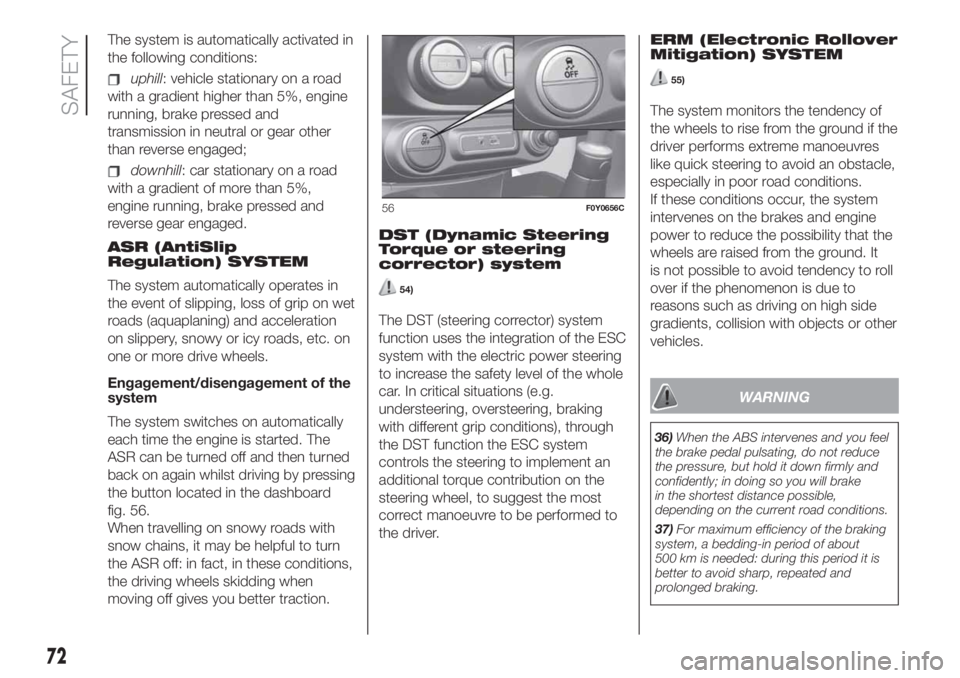
The system is automatically activated in
the following conditions:
uphill: vehicle stationary on a road
with a gradient higher than 5%, engine
running, brake pressed and
transmission in neutral or gear other
than reverse engaged;
downhill: car stationary on a road
with a gradient of more than 5%,
engine running, brake pressed and
reverse gear engaged.
ASR (AntiSlip
Regulation) SYSTEM
The system automatically operates in
the event of slipping, loss of grip on wet
roads (aquaplaning) and acceleration
on slippery, snowy or icy roads, etc. on
one or more drive wheels.
Engagement/disengagement of the
system
The system switches on automatically
each time the engine is started. The
ASR can be turned off and then turned
back on again whilst driving by pressing
the button located in the dashboard
fig. 56.
When travelling on snowy roads with
snow chains, it may be helpful to turn
the ASR off: in fact, in these conditions,
the driving wheels skidding when
moving off gives you better traction.DST (Dynamic Steering
Torque or steering
corrector) system
54)
The DST (steering corrector) system
function uses the integration of the ESC
system with the electric power steering
to increase the safety level of the whole
car. In critical situations (e.g.
understeering, oversteering, braking
with different grip conditions), through
the DST function the ESC system
controls the steering to implement an
additional torque contribution on the
steering wheel, to suggest the most
correct manoeuvre to be performed to
the driver.ERM (Electronic Rollover
Mitigation) SYSTEM
55)
The system monitors the tendency of
the wheels to rise from the ground if the
driver performs extreme manoeuvres
like quick steering to avoid an obstacle,
especially in poor road conditions.
If these conditions occur, the system
intervenes on the brakes and engine
power to reduce the possibility that the
wheels are raised from the ground. It
is not possible to avoid tendency to roll
over if the phenomenon is due to
reasons such as driving on high side
gradients, collision with objects or other
vehicles.
WARNING
36)When the ABS intervenes and you feel
the brake pedal pulsating, do not reduce
the pressure, but hold it down firmly and
confidently; in doing so you will brake
in the shortest distance possible,
depending on the current road conditions.
37)For maximum efficiency of the braking
system, a bedding-in period of about
500 km is needed: during this period it is
better to avoid sharp, repeated and
prolonged braking.
56F0Y0656C
72
SAFETY
Page 78 of 248
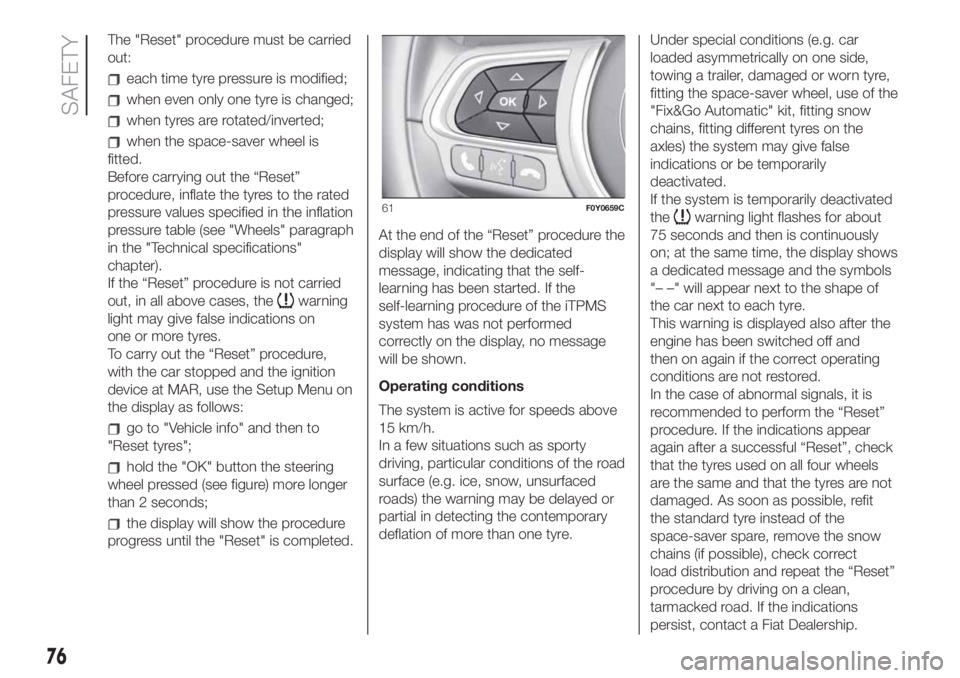
The "Reset" procedure must be carried
out:
each time tyre pressure is modified;
when even only one tyre is changed;
when tyres are rotated/inverted;
when the space-saver wheel is
fitted.
Before carrying out the “Reset”
procedure, inflate the tyres to the rated
pressure values specified in the inflation
pressure table (see "Wheels" paragraph
in the "Technical specifications"
chapter).
If the “Reset” procedure is not carried
out, in all above cases, the
warning
light may give false indications on
one or more tyres.
To carry out the “Reset” procedure,
with the car stopped and the ignition
device at MAR, use the Setup Menu on
the display as follows:
go to "Vehicle info" and then to
"Reset tyres";
hold the "OK" button the steering
wheel pressed (see figure) more longer
than 2 seconds;
the display will show the procedure
progress until the "Reset" is completed.At the end of the “Reset” procedure the
display will show the dedicated
message, indicating that the self-
learning has been started. If the
self-learning procedure of the iTPMS
system has was not performed
correctly on the display, no message
will be shown.
Operating conditions
The system is active for speeds above
15 km/h.
In a few situations such as sporty
driving, particular conditions of the road
surface (e.g. ice, snow, unsurfaced
roads) the warning may be delayed or
partial in detecting the contemporary
deflation of more than one tyre.Under special conditions (e.g. car
loaded asymmetrically on one side,
towing a trailer, damaged or worn tyre,
fitting the space-saver wheel, use of the
"Fix&Go Automatic" kit, fitting snow
chains, fitting different tyres on the
axles) the system may give false
indications or be temporarily
deactivated.
If the system is temporarily deactivated
the
warning light flashes for about
75 seconds and then is continuously
on; at the same time, the display shows
a dedicated message and the symbols
"– –" will appear next to the shape of
the car next to each tyre.
This warning is displayed also after the
engine has been switched off and
then on again if the correct operating
conditions are not restored.
In the case of abnormal signals, it is
recommended to perform the “Reset”
procedure. If the indications appear
again after a successful “Reset”, check
that the tyres used on all four wheels
are the same and that the tyres are not
damaged. As soon as possible, refit
the standard tyre instead of the
space-saver spare, remove the snow
chains (if possible), check correct
load distribution and repeat the “Reset”
procedure by driving on a clean,
tarmacked road. If the indications
persist, contact a Fiat Dealership.61F0Y0659C
76
SAFETY
Page 83 of 248
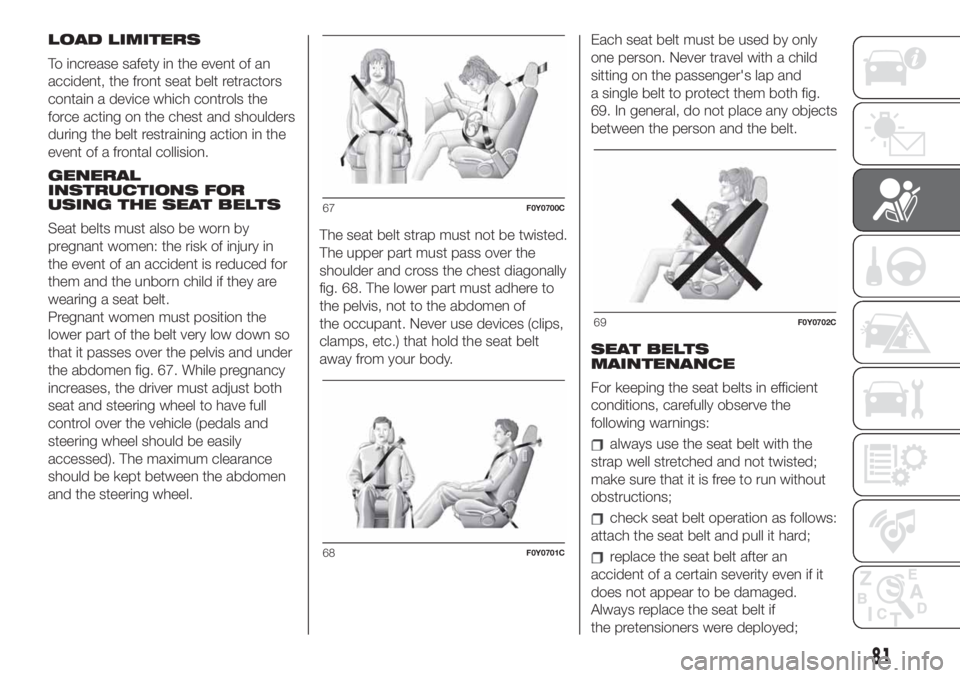
LOAD LIMITERS
To increase safety in the event of an
accident, the front seat belt retractors
contain a device which controls the
force acting on the chest and shoulders
during the belt restraining action in the
event of a frontal collision.
GENERAL
INSTRUCTIONS FOR
USING THE SEAT BELTS
Seat belts must also be worn by
pregnant women: the risk of injury in
the event of an accident is reduced for
them and the unborn child if they are
wearing a seat belt.
Pregnant women must position the
lower part of the belt very low down so
that it passes over the pelvis and under
the abdomen fig. 67. While pregnancy
increases, the driver must adjust both
seat and steering wheel to have full
control over the vehicle (pedals and
steering wheel should be easily
accessed). The maximum clearance
should be kept between the abdomen
and the steering wheel.The seat belt strap must not be twisted.
The upper part must pass over the
shoulder and cross the chest diagonally
fig. 68. The lower part must adhere to
the pelvis, not to the abdomen of
the occupant. Never use devices (clips,
clamps, etc.) that hold the seat belt
away from your body.Each seat belt must be used by only
one person. Never travel with a child
sitting on the passenger's lap and
a single belt to protect them both fig.
69. In general, do not place any objects
between the person and the belt.
SEAT BELTS
MAINTENANCE
For keeping the seat belts in efficient
conditions, carefully observe the
following warnings:
always use the seat belt with the
strap well stretched and not twisted;
make sure that it is free to run without
obstructions;
check seat belt operation as follows:
attach the seat belt and pull it hard;
replace the seat belt after an
accident of a certain severity even if it
does not appear to be damaged.
Always replace the seat belt if
the pretensioners were deployed;
67F0Y0700C
68F0Y0701C
69F0Y0702C
81
Page 97 of 248
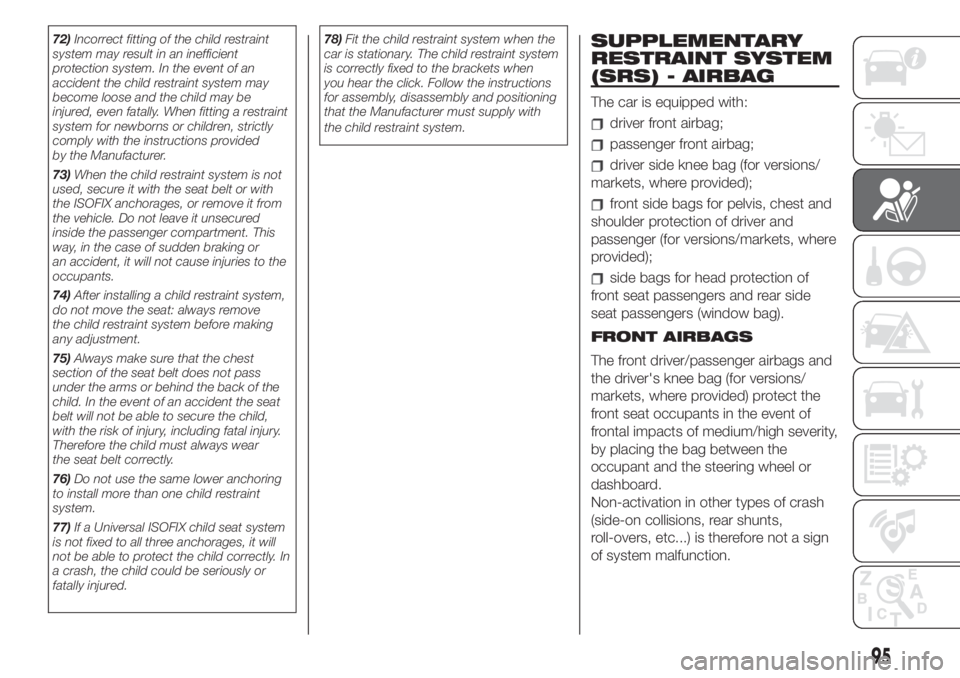
72)Incorrect fitting of the child restraint
system may result in an inefficient
protection system. In the event of an
accident the child restraint system may
become loose and the child may be
injured, even fatally. When fitting a restraint
system for newborns or children, strictly
comply with the instructions provided
by the Manufacturer.
73)When the child restraint system is not
used, secure it with the seat belt or with
the ISOFIX anchorages, or remove it from
the vehicle. Do not leave it unsecured
inside the passenger compartment. This
way, in the case of sudden braking or
an accident, it will not cause injuries to the
occupants.
74)After installing a child restraint system,
do not move the seat: always remove
the child restraint system before making
any adjustment.
75)Always make sure that the chest
section of the seat belt does not pass
under the arms or behind the back of the
child. In the event of an accident the seat
belt will not be able to secure the child,
with the risk of injury, including fatal injury.
Therefore the child must always wear
the seat belt correctly.
76)Do not use the same lower anchoring
to install more than one child restraint
system.
77)If a Universal ISOFIX child seat system
is not fixed to all three anchorages, it will
not be able to protect the child correctly. In
a crash, the child could be seriously or
fatally injured.78)Fit the child restraint system when the
car is stationary. The child restraint system
is correctly fixed to the brackets when
you hear the click. Follow the instructions
for assembly, disassembly and positioning
that the Manufacturer must supply with
the child restraint system.SUPPLEMENTARY
RESTRAINT SYSTEM
(SRS) - AIRBAG
The car is equipped with:
driver front airbag;
passenger front airbag;
driver side knee bag (for versions/
markets, where provided);
front side bags for pelvis, chest and
shoulder protection of driver and
passenger (for versions/markets, where
provided);
side bags for head protection of
front seat passengers and rear side
seat passengers (window bag).
FRONT AIRBAGS
The front driver/passenger airbags and
the driver's knee bag (for versions/
markets, where provided) protect the
front seat occupants in the event of
frontal impacts of medium/high severity,
by placing the bag between the
occupant and the steering wheel or
dashboard.
Non-activation in other types of crash
(side-on collisions, rear shunts,
roll-overs, etc...) is therefore not a sign
of system malfunction.
95
Page 98 of 248
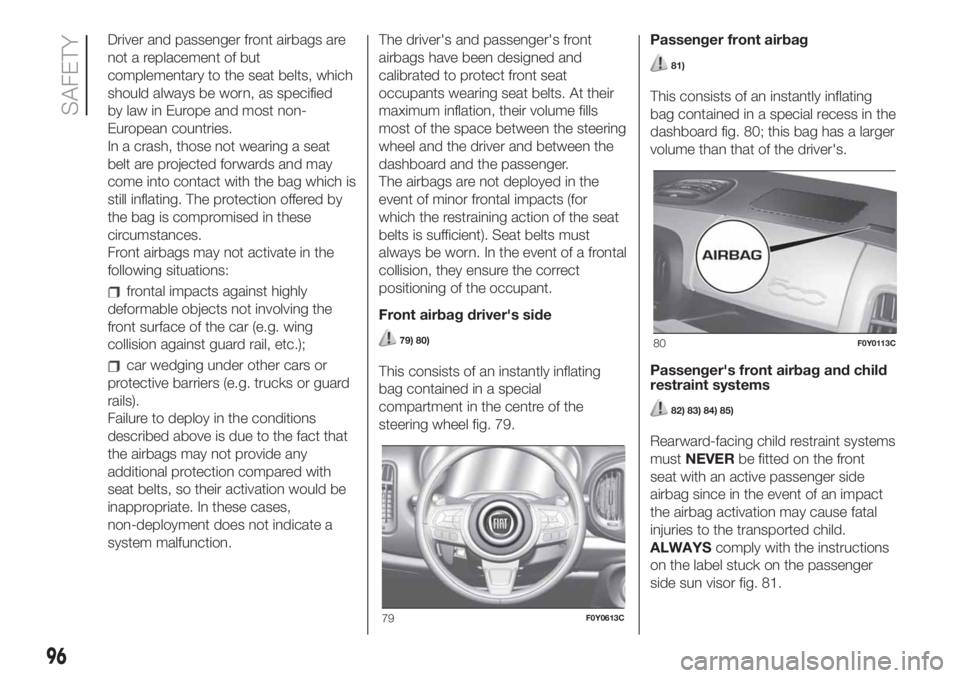
Driver and passenger front airbags are
not a replacement of but
complementary to the seat belts, which
should always be worn, as specified
by law in Europe and most non-
European countries.
In a crash, those not wearing a seat
belt are projected forwards and may
come into contact with the bag which is
still inflating. The protection offered by
the bag is compromised in these
circumstances.
Front airbags may not activate in the
following situations:
frontal impacts against highly
deformable objects not involving the
front surface of the car (e.g. wing
collision against guard rail, etc.);
car wedging under other cars or
protective barriers (e.g. trucks or guard
rails).
Failure to deploy in the conditions
described above is due to the fact that
the airbags may not provide any
additional protection compared with
seat belts, so their activation would be
inappropriate. In these cases,
non-deployment does not indicate a
system malfunction.The driver's and passenger's front
airbags have been designed and
calibrated to protect front seat
occupants wearing seat belts. At their
maximum inflation, their volume fills
most of the space between the steering
wheel and the driver and between the
dashboard and the passenger.
The airbags are not deployed in the
event of minor frontal impacts (for
which the restraining action of the seat
belts is sufficient). Seat belts must
always be worn. In the event of a frontal
collision, they ensure the correct
positioning of the occupant.
Front airbag driver's side
79) 80)
This consists of an instantly inflating
bag contained in a special
compartment in the centre of the
steering wheel fig. 79.Passenger front airbag
81)
This consists of an instantly inflating
bag contained in a special recess in the
dashboard fig. 80; this bag has a larger
volume than that of the driver's.
Passenger's front airbag and child
restraint systems
82) 83) 84) 85)
Rearward-facing child restraint systems
mustNEVERbe fitted on the front
seat with an active passenger side
airbag since in the event of an impact
the airbag activation may cause fatal
injuries to the transported child.
ALWAYScomply with the instructions
on the label stuck on the passenger
side sun visor fig. 81.
79F0Y0613C
80F0Y0113C
96
SAFETY
Page 101 of 248
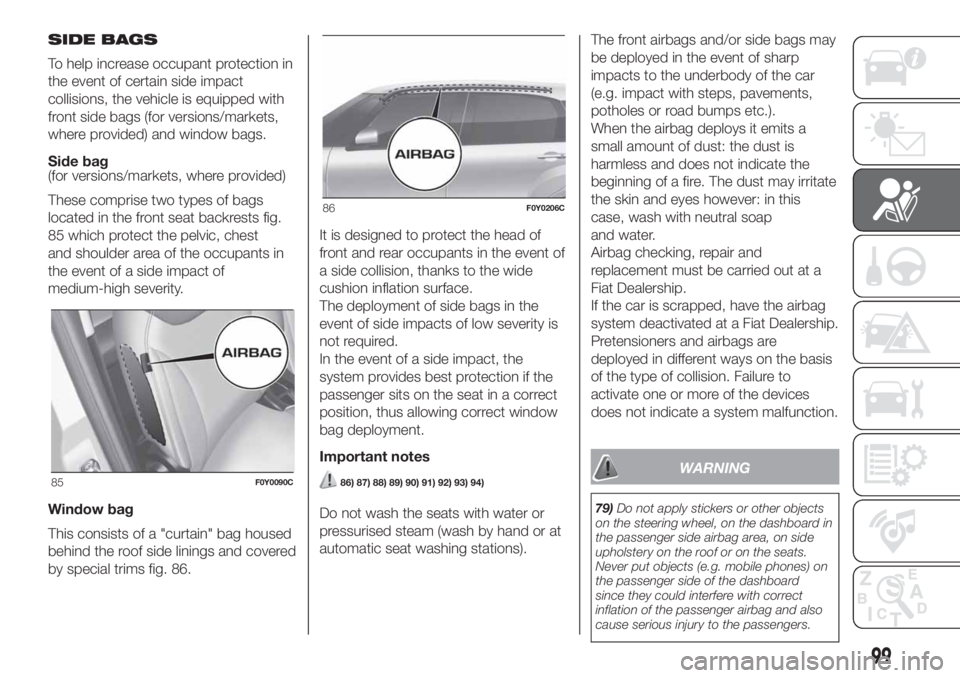
SIDE BAGS
To help increase occupant protection in
the event of certain side impact
collisions, the vehicle is equipped with
front side bags (for versions/markets,
where provided) and window bags.
Side bag
(for versions/markets, where provided)
These comprise two types of bags
located in the front seat backrests fig.
85 which protect the pelvic, chest
and shoulder area of the occupants in
the event of a side impact of
medium-high severity.
Window bag
This consists of a "curtain" bag housed
behind the roof side linings and covered
by special trims fig. 86.It is designed to protect the head of
front and rear occupants in the event of
a side collision, thanks to the wide
cushion inflation surface.
The deployment of side bags in the
event of side impacts of low severity is
not required.
In the event of a side impact, the
system provides best protection if the
passenger sits on the seat in a correct
position, thus allowing correct window
bag deployment.
Important notes
86) 87) 88) 89) 90) 91) 92) 93) 94)
Do not wash the seats with water or
pressurised steam (wash by hand or at
automatic seat washing stations).The front airbags and/or side bags may
be deployed in the event of sharp
impacts to the underbody of the car
(e.g. impact with steps, pavements,
potholes or road bumps etc.).
When the airbag deploys it emits a
small amount of dust: the dust is
harmless and does not indicate the
beginning of a fire. The dust may irritate
the skin and eyes however: in this
case, wash with neutral soap
and water.
Airbag checking, repair and
replacement must be carried out at a
Fiat Dealership.
If the car is scrapped, have the airbag
system deactivated at a Fiat Dealership.
Pretensioners and airbags are
deployed in different ways on the basis
of the type of collision. Failure to
activate one or more of the devices
does not indicate a system malfunction.
WARNING
79)Do not apply stickers or other objects
on the steering wheel, on the dashboard in
the passenger side airbag area, on side
upholstery on the roof or on the seats.
Never put objects (e.g. mobile phones) on
the passenger side of the dashboard
since they could interfere with correct
inflation of the passenger airbag and also
cause serious injury to the passengers.
85F0Y0090C
86F0Y0206C
99
Page 102 of 248
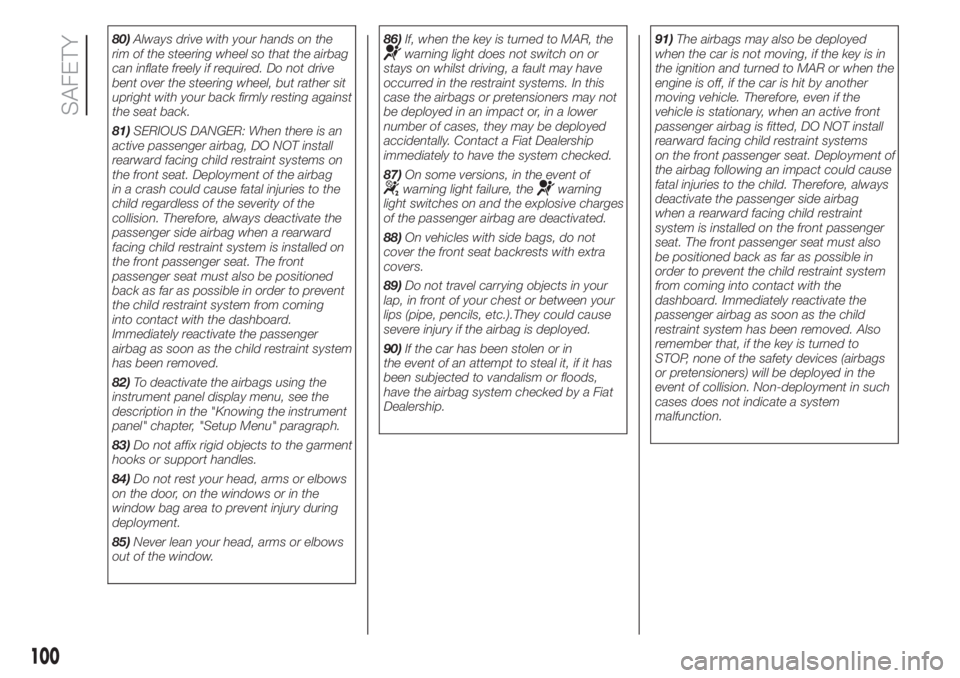
80)Always drive with your hands on the
rim of the steering wheel so that the airbag
can inflate freely if required. Do not drive
bent over the steering wheel, but rather sit
upright with your back firmly resting against
the seat back.
81)SERIOUS DANGER: When there is an
active passenger airbag, DO NOT install
rearward facing child restraint systems on
the front seat. Deployment of the airbag
in a crash could cause fatal injuries to the
child regardless of the severity of the
collision. Therefore, always deactivate the
passenger side airbag when a rearward
facing child restraint system is installed on
the front passenger seat. The front
passenger seat must also be positioned
back as far as possible in order to prevent
the child restraint system from coming
into contact with the dashboard.
Immediately reactivate the passenger
airbag as soon as the child restraint system
has been removed.
82)To deactivate the airbags using the
instrument panel display menu, see the
description in the "Knowing the instrument
panel" chapter, "Setup Menu" paragraph.
83)Do not affix rigid objects to the garment
hooks or support handles.
84)Do not rest your head, arms or elbows
on the door, on the windows or in the
window bag area to prevent injury during
deployment.
85)Never lean your head, arms or elbows
out of the window.86)If, when the key is turned to MAR, thewarning light does not switch on or
stays on whilst driving, a fault may have
occurred in the restraint systems. In this
case the airbags or pretensioners may not
be deployed in an impact or, in a lower
number of cases, they may be deployed
accidentally. Contact a Fiat Dealership
immediately to have the system checked.
87)On some versions, in the event of
warning light failure, thewarning
light switches on and the explosive charges
of the passenger airbag are deactivated.
88)On vehicles with side bags, do not
cover the front seat backrests with extra
covers.
89)Do not travel carrying objects in your
lap, in front of your chest or between your
lips (pipe, pencils, etc.).They could cause
severe injury if the airbag is deployed.
90)If the car has been stolen or in
the event of an attempt to steal it, if it has
been subjected to vandalism or floods,
have the airbag system checked by a Fiat
Dealership.91)The airbags may also be deployed
when the car is not moving, if the key is in
the ignition and turned to MAR or when the
engine is off, if the car is hit by another
moving vehicle. Therefore, even if the
vehicle is stationary, when an active front
passenger airbag is fitted, DO NOT install
rearward facing child restraint systems
on the front passenger seat. Deployment of
the airbag following an impact could cause
fatal injuries to the child. Therefore, always
deactivate the passenger side airbag
when a rearward facing child restraint
system is installed on the front passenger
seat. The front passenger seat must also
be positioned back as far as possible in
order to prevent the child restraint system
from coming into contact with the
dashboard. Immediately reactivate the
passenger airbag as soon as the child
restraint system has been removed. Also
remember that, if the key is turned to
STOP, none of the safety devices (airbags
or pretensioners) will be deployed in the
event of collision. Non-deployment in such
cases does not indicate a system
malfunction.
100
SAFETY